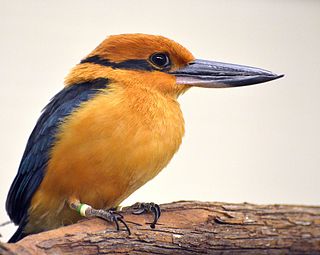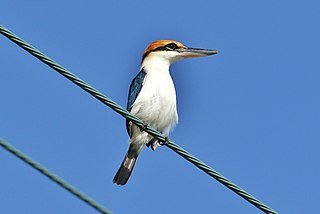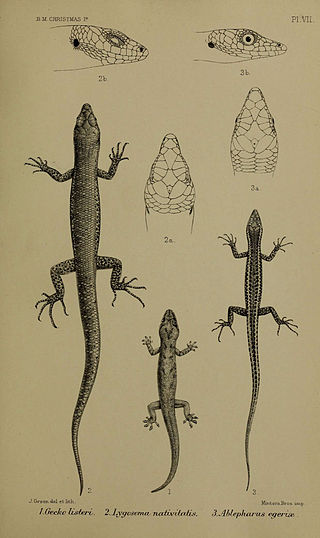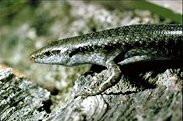
Micronesia is a subregion of Oceania, consisting of approximately 2,000 small islands in the Northwestern Pacific Ocean. It has a close shared cultural history with three other island regions: Maritime Southeast Asia to the west, Polynesia to the east, and Melanesia to the south—as well as with the wider community of Austronesian peoples.

Nauru, officially the Republic of Nauru and formerly known as Pleasant Island, is an island country in Micronesia, part of the Oceania region in the Central Pacific. It is a microstate and its nearest neighbour is Banaba of Kiribati about 300 km (190 mi) to the east.

The Guam kingfisher, called sihek in Chamorro, is a species of kingfisher from the United States Territory of Guam. It is restricted to a captive breeding program following its extinction in the wild due primarily to predation by the introduced brown tree snake.

The Micronesian imperial pigeon, also known as the Micronesian pigeon, and Belochel is a species of bird in the family Columbidae (doves). It is found in Palau, the Caroline Islands, the Marshall Islands and Nauru. Its habitats include montane forests, secondary forests, forests on beaches, and mangroves. It is threatened by hunting and deforestation, and the IUCN has assessed it as a near-threatened species.

The Nauru reed warbler is a passerine bird endemic to the island of Nauru in the Pacific Ocean. It is one of only two native breeding land-birds on Nauru and it is the only passerine found on the island. It is related to other Micronesian reed warblers, all of which evolved from one of several radiations of the genus across the Pacific. Related warblers on nearby islands include the Caroline reed warbler, with which the Nauru species was initially confused, and the nightingale reed warbler, which was formerly sometimes considered the same species.

Emoia caeruleocauda, commonly known as the Pacific bluetail skink or Pacific blue-tail skink, is a species of lizard in the family Scincidae. It is widespread in the Indo-West Pacific.

Emoia atrocostata, commonly known as the littoral whiptail-skink, mangrove skink, or littoral skink, is a species of lizard in the family Scincidae. It inhabits mangroves, back-beach vegetation and rocky shorelines. It is semi-aquatic and forages in tidal pools.

The rusty-capped kingfisher or Palau kingfisher is a species of bird in the family Alcedinidae. It is endemic to Palau. The natural habitat of this species is subtropical or tropical moist lowland forests. It was formerly considered to be a subspecies of the Micronesian kingfisher.

The Christmas Island forest skink, also known as the Christmas Island whiptail skink, is an extinct species of skink formerly endemic to Australia's Christmas Island. As of 2017, it is listed as extinct on the IUCN Red List. The last known forest skink, a captive individual named Gump, died on 31 May 2014.

Emoia impar, also known as the dark-bellied copper-striped skink, or the azure-tailed skink is a species of skink that is widespread in the Pacific, especially Polynesia and Micronesia.
Emoia sanfordi, known commonly as Sanford's emo skink and Sanford's tree skink, is a species of lizard in the family Scincidae. The species is endemic to Vanuatu.

Emoia adspersa, Steindachner's emo skink, the Micronesian skink, dark-sided emoia, dark-sided skink, or dateline emoia, is a species of lizard in the family Scincidae. It is found in Micronesia. The species has also been noted to occur on Niuafoʻou, the northernmost island of Tonga, with sightings in 1930 and 1994. The species is not present on other Tongan islands, and is possibly present due to waif dispersal occurring during Polynesian migration.

Emoia boettgeri, also known commonly as Boettger's emo skink, the Micronesia forest skink, and the Micronesia spotted skink, is a species of lizard in the family Scincidae. The species is native to Micronesia. There are no recognized subspecies.
Emoia campbelli, also known commonly as Campbell's skink, the montane emo skink, and the Vitilevu mountain treeskink, is a species of lizard in the family Scincidae. The species is endemic to the island of Viti Levu in Fiji.

Emoia lawesii, also commonly known as Günther's emo skink and the olive small-scaled skink, is a species of lizard in the subfamily Eugongylinae of the family Scincidae. The species is native to Polynesia.
Kiester's emo skink or Ponape skink is a species of lizard in the family Scincidae occurring in Micronesia.
Emoia schmidti, also known commonly as Schmidt's emo skink or Schmidt's skink, is a species of lizard in the family Scincidae. The species is endemic to the Solomon Islands.

Emoia slevini, also known commonly as the Mariana skink, Slevin's brown skink, Slevin's emo skink, and Slevin's skink, is a species of lizard in the family Scincidae. The species is endemic to the Mariana Islands.
Emoia trossula, also known commonly as the Fiji barred treeskink, Gibbons's emo skink, and the Viti barred treeskink, is a species of lizard in the family Scincidae. The species is native to archipelagos in the tropical Pacific Ocean.














